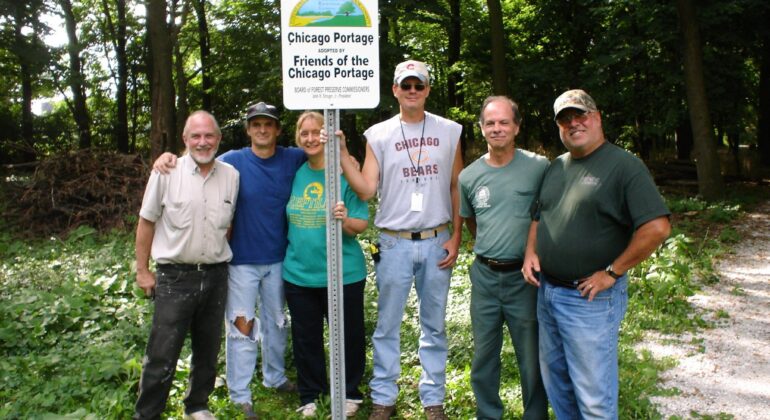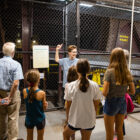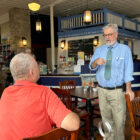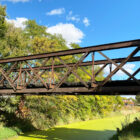by Nancy Uznanski
About twenty five years ago while working for the I&M Canal National Heritage Corridor Civic Center Authority, part of his job was to help promote the I&M Canal National Heritage Corridor, he said. When he learned the Canal was dug because of a comment Frenchman Louis Jolliet made following an expedition, he was amazed.
In 1673, Jolliet and Father Jacques Marquette were commissioned to travel from Wisconsin down the Mississippi River by canoe, to see where it went. At the recommendation of Native Americans, on their return they left the Mississippi near St. Louis and took a short-cut, northeast up the Illinois River to Lake Michigan.
About 12 miles from the lake they had to portage, carry their canoes and supplies, from the west end of what was often called Mud Lake, east to the Chicago River. His comment is in the following quote.
“The importance of “Le Portage-e de Checago” was realized even in the era of early French exploration. Jolliet reported that “it would only be necessary to cut a canal through half a league of prairie to go in a bark (canoe) by easy navigation from Lake Erie to the Gulf of Mexico.” (He saw the site about September 1, when it was between dry and wet seasons.),” according to the Friends of the Chicago Portage web site Chicago Portage-Historical Synopsis – Chicago Portage and Laughton Trading Post Area.
The idea was remembered for more than 150 years before the canal was created. However river levels fluctuated so much more than Jolliet knew, the canal had to be much longer than the mile and a half he suggested. The hand dug canal was 96 miles long when at LaSalle it opened to the consistently navigable part of the Illinois River. It also opened the Mid-West to trade, just as Jolliet thought it could.
“I’m a third generation Chicagoan,” Mechanic said. “Through 12 years of public school I learned nothing of this! And Illinois mandates that local history studies are supposed to be part of the school curriculum. There’s so much multicultural history here because of the Chicago Portage, people should know about it.”
Mechanic learned that the entry to a portion of the western section of the portage was in the Forest Preserve District of Cook County, Portage Woods, in the Village of Lyons. He also learned it was a National Historic Site. Plus there was a handsome, bigger-than-life sculpture representing Joliet, Marquette and an Indian Guide starting to lift a canoe out of the water.
According to Cathy Geraghty of the Forest Preserve District, in 1929 the Sanitary District of Chicago granted the site to the Forest Preserve District of Cook County to protect it. She also said it was declared a National Historic Site by the U.S. Government in 1952.
12.22 On Mechanic’s first visit, he said “Although the statue was visible, the woods was so overgrown with invasive plants, you could go 10 feet into the woods and you wouldn’t be able to see the statue or parking lot anymore.”
Obtaining grants, he used one to fund a teacher-created fourth grade curriculum. With the other, he funded a new group, the Friends of the Chicago Portage (Friends). For the next two years they gave free weekly public tours of the Chicago Portage Site.
Once funds ran out, he continued with Friends. “I got hooked,” Mechanic said. “Starting in 2002, on the 50th anniversary of its designation as Chicago Portage National Historic Site, we started doing ecological restoration.”
Ever since, with a little “sweat-equity,” he said Friends volunteers have helped one day a month to clean, clear, plant and restore natural habitat at the site. We also provided free tours on the first Saturday of the month, May through November, and other programs and lectures during the winter months. “We still do,” he added.
“They’ve been great,” Geraghty said. “They’ve helped developed a lot of interest and they still partner with us.”
She also noted that huge strides have been made since about 2010 when the Forest Preserve’s governing body created a communications department and updated their master plan for the site.
Today, thanks to the Friends and partnerships with the I&M Canal Commission and the National Park Service, the Forest Preserve has come a long way in bringing people in to enjoy and learn about the Chicago Portage, according to Ana B. Koval, President CEO I&M Canal Corridor Association.
The 350th Anniversary of Jolliet and Marquette’s expedition down the Mississippi will be this May. Mechanic said he hopes more people than ever will visit the site and imagine what it might have been like long ago.
He also said they hope many will head out to enjoy a free, special Chicago Portage Day event on Saturday, Aug 12 hosted by the Friends, the Forest Preserve District, the National Park Service and other organizations.
Nancy Uznanski is a freelance writer.




